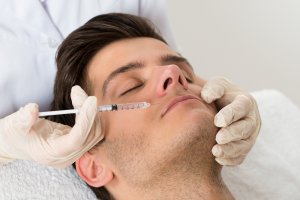Why Do Men Get Botox & Fillers?

Would it surprise you if we said more men are fighting ageism with Botox and dermal fillers?
New medical aesthetics industry statistics show that there has been a dramatic rise in the number of men getting cosmetic procedures. Other motivating factors include social media and having a competitive edge at work.
Why Do Men Get Botox and Fillers?
There has been a staggering rise in the number of men getting cosmetic procedures. Since 2010, the American Society of Plastic Surgery (ASPS) reported a 20 percent increase in the number of men requesting plastic surgery, with a vast majority opting for minimally invasive procedures like facial fillers to reduce wrinkles and restore lost volume in the face.
The number of men getting Botox has increased nearly 27 percent during the same time span, which has led several media outlets to use the term “Brotox.”
While there is no national data on why men choose to get work done, several physicians have seen a steady uptick in the number of men seeking Botox. Some are in their 20s to 30s and want to do some preventive Botox to soften dynamic wrinkles. Others are entering a new stage of life (career change, divorce, etc.) or worried about looking older at work.
Even Allergan, the creator of Botox, is betting on Botox for men. The company rolled out TV spots targeting male consumers that feature a familiar face: Deion Sanders. The TV analyst, Hall of Famer and former pro football player is now the spokesperson for the Botox brand.
What is Botox?
Botox Cosmetic is a nonsurgical, anti-aging treatment that lessens the appearance of facial wrinkles and creases that develop with sun damage and age. Approved by the Food and Drug Administration (FDA) in 2002, botulinum toxin injections are used to treat between the eyes (glabella), forehead lines and crow’s feet. Botox is a lunchtime procedure that can take as little as 15 minutes and can drastically improve the appearance of the face.
Physicians and nurses commonly use Botox for men to help slim the face by injecting the masseter muscle along the jawline or in the chin to prevent dimpling of the skin. Another common use for Botox is to stop sweating. Research has found an 82 to 87 percent decrease in sweat production in the underarms after a Botox treatment.
Botox Training at National Laser Institute
If you are a physician, nurse or medical professional looking to increase your service menu, consider Botox training at National Laser Institute! We offer CE/CME training courses that can be completed in as little as a weekend up to two weeks of training.
With over a decade of excellence, our courses combine classroom education and clinical hands-on training for the ultimate learning experience.
The didactic portion of the course will teach you everything you need to know about the various types of neurotoxins and fillers, the aging process, indications for Botox treatments and safety.
Clinicals are spent in a medical spa environment where you will observe comprehensive Botox and fillers demonstrations no more than a foot away from the training bed, and you will administer these cosmetic treatments on real, paying clients.
By the end of a Botox and dermal fillers training course at National Laser Institute, you will feel comfortable and confident performing a variety of cosmetic treatments, including Botox, dermal fillers (Restylane®, Perlane® and Juvederm®), Kybella, platelet-rich plasma (PRP), PDO threads and more!
For more information on National Laser Institute’s continuing education courses, fill out the form on your right or give us a call at 1-800-982-6817.








